
The Passage Choiseul is one of the covered passages of Paris, located in the 2nd arrondissement. [1] It is the continuation of the Rue de Choiseul.

The Passage Choiseul is one of the covered passages of Paris, located in the 2nd arrondissement. [1] It is the continuation of the Rue de Choiseul.
The Passage Choiseul is on a site previously occupied by four hôtels particuliers , acquired by the Mallet Bank for a real-estate development that included the Opéra-Comique's nearby Salle Ventadour. [2] The passage was built between 1826 and 1827, first to the designs of the architect François Mazois , then Antoine Tavernier. [2] Mazois died before the building was complete, and Tavernier completed the work. [3]
The author Louis-Ferdinand Céline lived there as a child in the early 20th century. The Passage Choiseul is mentioned in two of his novels: Journey to the End of the Night and Death on the Installment Plan . [2] Céline described it as having gas lamps that "stank as badly as the stagnant air", and the aroma of "dogs urine" in the passage. [1]
In 1907, the glass roof was replaced (although its ironwork dates from 1891 [4] ). The passage later fell into disrepair. In the 1970s, visitation increased when Kenzo opened a boutique in the passage. They have since relocated to the Place des Victoires.[ citation needed ]
The Passage Choiseul is a shopping and food area. It has restaurants, clothing stores, book stores, jewellery shops, art galleries, art supply shops and a hair stylist. The entrance to the Théâtre des Bouffes-Parisiens is located in the passage. [1] The ground floor is mainly retail and the upper floors are primarily residential. It is the longest covered passage in the city, at 190 meters long and 3.7 meters wide. In 2012, renovations and restoration were begun under Jean Frédéric Grevet. It is a registered historic monument in France. [3]
| Located near the Métro stations: Pyramides and Quatre-Septembre . |
It is just west of the Galerie Vivienne on the Rue des Petits-Champs in the 2nd arrondissement. [1]

The Académie Julian was a private art school for painting and sculpture founded in Paris, France, in 1867 by French painter and teacher Rodolphe Julian (1839–1907) that was active from 1868 through 1968. It remained famous for the number and quality of artists who attended during the great period of effervescence in the arts in the early twentieth century. After 1968, it integrated with ESAG Penninghen.

The 2nd arrondissement of Paris is one of the 20 arrondissements of the capital city of France. In spoken French, this arrondissement is colloquially referred to as deuxième. It is governed locally together with the 1st, 3rd and 4th arrondissement, with which it forms the 1st sector of Paris.
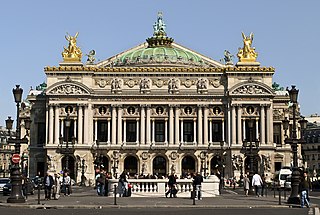
The 9th arrondissement of Paris is one of the 20 arrondissements of the capital city of France. In spoken French, it is referred to as le neuvième.
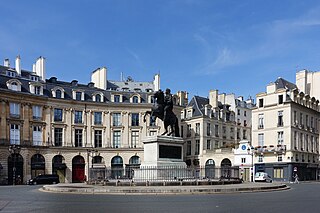
The Place des Victoires is a circular square in central Paris, located a short distance northeast of the Palais-Royal and straddling the border between the 1st and the 2nd arrondissements. The Place des Victoires is at the confluence of six streets: the Rue de la Feuillade, Rue Vide-Gousset, Rue d'Aboukir, Rue Étienne-Marcel, Rue Croix-des-Petits-Champs and Rue Catinat.

The Rue Montorgueil is a street in the 1st arrondissement and 2nd arrondissement of Paris, France. Lined with restaurants, cafés, bakeries, fish stores, cheese shops, wine shops, produce stands and flower shops, the Rue Montorgueil is a place for Parisians to socialize while doing their daily shopping. At the southernmost tip of the Rue Montorgueil is Saint-Eustache Church, and Les Halles, containing the largest indoor shopping mall in central Paris; and to the north is the area known as the Grands Boulevards. While cars are not banned from the street, the priority is for pedestrians who can enjoy the cafés and shops while walking down the cobblestones.
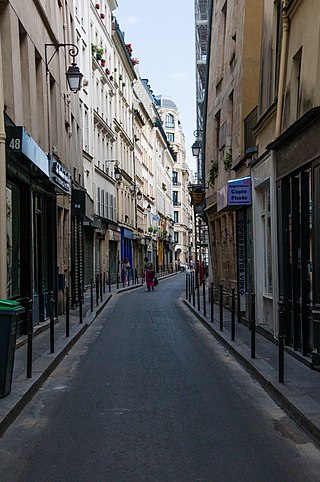
The Rue de Montmorency is a street in the historic Le Marais quarter of Paris, part of the city's 3rd arrondissement. It runs from the Rue du Temple to the Rue Saint-Martin.
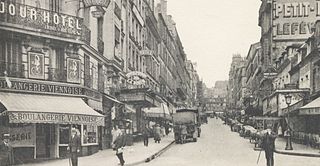
Rue Lepic is a street in the former commune of Montmartre, in the 18th arrondissement of Paris, climbing the hill of Montmartre from the Boulevard de Clichy to Place Jean-Baptiste-Clément.

Henri Sauvage was a French architect and designer in the early 20th century. He was one of the most important architects in the French Art nouveau movement, Art Deco, and the beginning of architectural modernism. He was also a pioneer in the construction of public housing buildings in Paris. His major works include the art nouveau Villa Majorelle in Nancy, France and the art-deco building of the La Samaritaine department store in Paris.
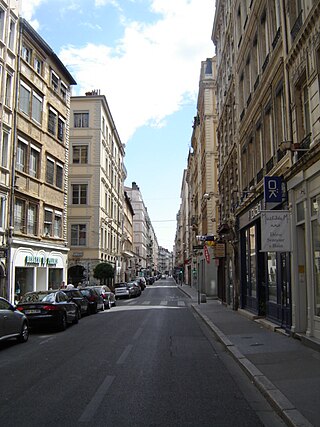
The Rue de Brest is a street located in the 2nd arrondissement of Lyon. This is one of the main shopping and tourist streets of the city center, parallel to the rue Édouard-Herriot. It begins in the wake of the rue Paul Chenavard and ends with the Place des Jacobins.

The Galerie Véro-Dodat is one of the covered passages of Paris. It is located in the 1st arrondissement, connecting the Rue de Jean-Jacques Rousseau and the Rue Croix-des-Petits-Champs. It was built in 1826.

The Galerie Vivienne is one of the covered passages of Paris, located in the 2nd arrondissement. It is 176 metres (577 ft) long and 3 metres (9.8 ft) wide. The gallery has been registered as a historical monument since 7 July 1974.

The Passage Jouffroy is one of the covered passages of Paris, located in the 9th arrondissement. It runs between the Boulevard Montmartre to the south and the Rue de la Grange-Batelière to the north.
This article presents the main landmarks in the city of Paris within administrative limits, divided by its 20 arrondissements. Landmarks located in the suburbs of Paris, outside of its administrative limits, while within the metropolitan area are not included in this article.
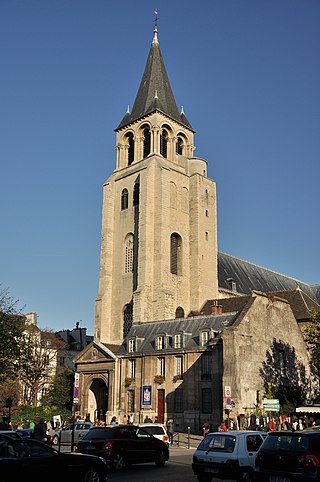
The city of Paris has notable examples of architecture of every period, from the Middle Ages to the 21st century. It was the birthplace of the Gothic style, and has important monuments of the French Renaissance, Classical revival, the Flamboyant style of the reign of Napoleon III, the Belle Époque, and the Art Nouveau style. The great Exposition Universelle (1889) and 1900 added Paris landmarks, including the Eiffel Tower and Grand Palais. In the 20th century, the Art Deco style of architecture first appeared in Paris, and Paris architects also influenced the postmodern architecture of the second half of the century.
The covered passages of Paris are an early form of shopping arcade built in Paris, France, primarily during the first half of the 19th century. By 1867, there were approximately 183 covered passages in Paris but many were demolished during Haussmann's renovation of Paris. Only 25 survived into the 21st century, all but one are in the arrondissements on the Right Bank of the Seine.

The Théâtre Comte, also called Théâtre des Jeunes-Élèves, was a Parisian entertainment venue founded by the ventriloquist and magician Louis Comte in 1820. The building was located in the passage des Panoramas of the 2nd arrondissement of Paris.
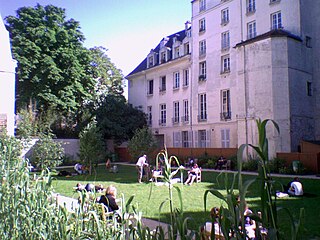
The Rosiers–Joseph Migneret Garden is a green space located in the 4th arrondissement of Paris.
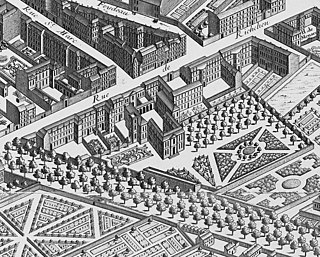
The Hôtel de Crozat, later the Hôtel de Choiseul, was a Parisian hôtel particulier, constructed in 1704 to the designs of the French architect Jean-Sylvain Cartaud for the rich banker and art collector Pierre Crozat. It was located on the west side of the rue de Richelieu, south of its intersection with the Grand Boulevard. The Duke of Choiseul acquired the hôtel in 1750. It was demolished in 1780, the property subdivided, and a theatre, the Salle Favart, constructed in the former garden.

The Rue de Valois is a street in the Palais-Royal quarter in the 1st arrondissement of Paris, France.

The Rue des Petits-Champs is a street that runs through the 1st and 2nd arrondissement of Paris, France.